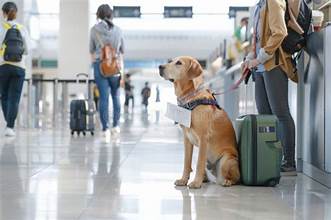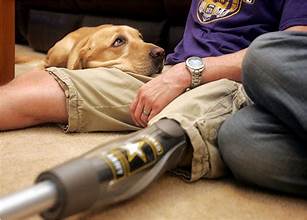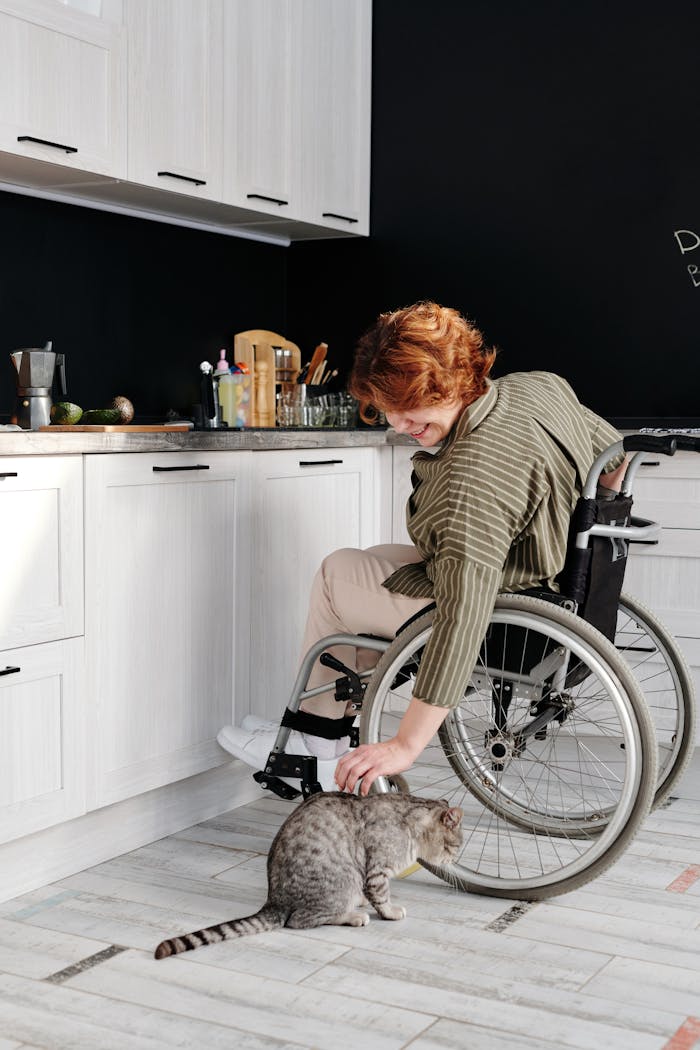If you’ve ever thought about flying with your service animal, you already know it can feel like a mix of excitement and anxiety. Whether you’re traveling for a family vacation, visiting loved ones, or heading to an appointment far from home, the thought of navigating airports, security lines, and airplane seats with your furry partner can feel overwhelming.
As a parent of a child with Autism who relies on the comfort and support of a trained service animal, I’ve been there. I remember our first flight vividly — the noise, the stares, the stress, and the deep sigh of relief when we finally landed, and my child’s service dog calmly rested under the seat. That day taught me a lot about preparation, patience, and advocacy.
This guide is designed to alleviate the fear and confusion associated with the process. I’ll walk you through everything you need to know — from airline rules and documentation to packing tips, airport routines, and what to expect once you’re in the air. So, grab your coffee, take a breath, and let’s dive in together.
🐶 What Counts as a Service Animal (and What Doesn’t)
Before booking your flight, it’s essential to understand what the Air Carrier Access Act (ACAA) defines as a service animal.
A service animal is a dog that has been individually trained to perform tasks for a person with a disability. This includes physical, sensory, psychiatric, intellectual, or other mental disabilities. Emotional support animals (ESAs) are no longer eligible for free travel in the cabin under this law.
That means:
- Trained service dogs (for autism, mobility, PTSD, diabetes alert, etc.) are allowed in the cabin.
- Emotional support animals, therapy animals, or comfort pets are not recognized as service animals and may be treated as regular pets (with fees and size restrictions).
So, if your animal performs a specific task — such as alerting to anxiety, interrupting meltdowns, or guiding through crowds — they’re protected as a service animal.
✍️ Step 1: Know the Airline Rules and Forms
Each airline has its own process, but most follow the U.S. Department of Transportation’s Service Animal Air Transportation Form. This form asks for:
- The handler’s name and contact information
- The dog’s training and behavior certification
- Health and vaccination details
- Confirmation that the animal is under control and won’t relieve itself inappropriately during the flight
You can find this form on each airline’s website, usually under their “Accessible Travel” or “Service Animals” section. It’s best to submit it at least 48 hours before your flight to avoid any issues at check-in.
💡 Pro tip: Print a copy of your form and keep it with your travel documents for easy reference. Not every gate agent or staff member will have access to their online system, and having a paper copy can prevent unnecessary stress.
🧳 Step 2: Preparing for the Trip (Packing for You and Your Service Dog)
Flying with a service animal means packing for two! I like to think of it as a “team travel kit.” Here’s what I always include:
For Your Service Animal:
- Service vest and ID (not legally required, but helps avoid confusion)
- Leash and backup leash
- Collapsible water bowl
- Small treat pouch
- Waste bags
- Favorite chew toy or comfort item
- A travel mat or blanket (helps your dog settle under the seat)
- Copies of vaccination and health records
- Medications (if any)
For You (and your family):
- Snacks and water (especially if your child is neurodivergent and sensitive to hunger or texture)
- Noise-canceling headphones or fidgets
- Wipes and sanitizer
- Change of clothes (accidents happen — for both humans and dogs!)
- Copy of your service dog paperwork and airline form
If you’re traveling internationally, check the entry requirements for animals in the destination country. Some countries have strict quarantine or vaccination rules, and you don’t want any surprises at customs.
🛫 Step 3: At the Airport — What to Expect
Arriving Early
Arrive at least two hours before domestic flights (three hours for international flights). This gives you time to check in, go through security, and find relief areas without rushing.
When you check in, let the gate agent know you’re traveling with a service dog. They’ll confirm your form and often offer pre-boarding so your dog can settle before the crowd boards.
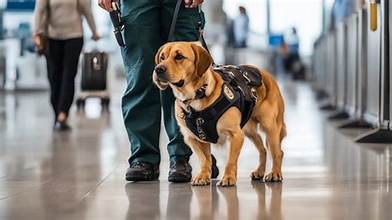
Going Through TSA
This is where many people get nervous — but don’t worry, it’s easier than you think.
When you reach TSA:
- Keep your dog on a leash.
- You’ll walk through the metal detector together.
- TSA may ask you to remove the dog’s vest or gear (if it triggers the alarm).
- They might swab your hands for explosive residue — it’s quick and harmless.
If your child or dog becomes anxious, explain calmly to the TSA agent. Most agents are trained in accessibility and will accommodate requests for extra time or a quiet space.
💬 Parent tip: I tell my child ahead of time what the beeps and security area will sound like — that preparation alone helps reduce sensory overwhelm.
🚻 Service Animal Relief Areas
All major airports now have service animal relief areas inside or near terminals. Look for the paw-print signs or ask a gate agent to guide you. These are often small grassy or turf areas with waste bags and trash bins.
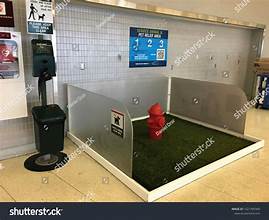
If your flight is long or you have a layover, plan breaks at these areas — even if your dog doesn’t go, it gives them a chance to stretch and reset.
💡 Pro tip: Bring an extra potty pad if your dog refuses to “go” in public or on artificial turf. Some dogs get shy in unfamiliar environments!
🪑 Step 4: Boarding and Seating
You have the right to sit anywhere your ticket allows, as long as your service dog fits safely at your feet without blocking aisles or exits. If your dog is large, bulkhead seats (the first row of the cabin) usually offer extra legroom.
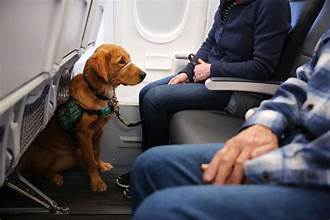
Ask politely at check-in or boarding if these seats are available — most airlines are accommodating when it comes to accessibility needs.
When you board:
- Guide your dog to your seat and use a “settle” or “under” command.
- Keep your leash short but relaxed.
- Avoid giving food or water until cruising altitude (to prevent upset stomachs).
Some flight attendants might offer water during the flight — feel free to accept if needed, but always keep your dog calm and comfortable.
😌 Step 5: In the Air — Staying Calm and Comfortable
Here’s where preparation pays off. Once you’re seated, take a deep breath. Most service dogs naturally go into “rest mode” during flights, but here are a few tricks I’ve learned along the way:
- Stay confident and calm. Your dog senses your emotions. The more relaxed you are, the more they’ll settle.
- Use gentle touch or verbal praise. A quiet “good boy” or “you’re doing great” goes a long way.
- Keep routines. My son’s service dog always gets a chew toy after takeoff — it’s become their cue that “we’re okay now.”
- Block distractions. Flights are noisy and full of smells; a familiar blanket or mat helps create a “safe zone.”
- Avoid petting requests. Most people are curious and kind, but it’s okay to say, “Thank you, but he’s working right now.”
If your dog gets restless, try subtle cues — like shifting your legs slightly or offering a calm “down” reminder. For anxious handlers or children, deep breathing exercises can help both of you.
🧾 Step 6: Landing and Arrival
When the plane touches down, wait for the seatbelt sign to turn off before moving. Let your dog stretch, but keep control as passengers exit. Once off the plane, head directly to the nearest relief area if your flight was long.
Customs and immigration officials (for international travel) may request your animal’s health documents, so keep them readily available.
If your child is sensitive to crowds or sudden noises, try to stay seated until most passengers have deplaned — the quiet helps make transitions smoother.
🌍 Special Considerations for International Travel
Flying internationally with a service animal adds a few extra steps:
- Research the destination country’s import rules. Some require advance paperwork or quarantine periods.
- Contact the destination airport for their service animal policies, especially regarding relief areas and customs checks.
- Carry a letter from your veterinarian confirming vaccinations and health status.
- Check airline policies for connecting flights — not all foreign carriers follow U.S. service animal laws.
Countries like the U.K., Australia, and Japan have stricter entry laws, so always confirm before booking.
❤️ My Personal Experience: Our First Flight Together
I’ll never forget our first flight with my son’s service dog, Max. We were flying to visit family for the holidays. My son had been anxious for weeks, worried about the loud noises and the idea of being “trapped” in a metal tube in the sky. But when we stepped into the airport, Max immediately went to work — calmly walking beside him, guiding him through crowds, offering gentle nudges when he started to fidget.
When the plane took off, my son squeezed my hand, then reached down to pet Max, who was already curled under the seat, eyes closed, tail still. By the time we landed, my son whispered, “I think Max likes flying.” It was a small sentence — but a massive moment of progress.
That trip reminded me why service animals are so much more than companions. They’re confidence, independence, and peace wrapped up in fur and loyalty.
💬 Common Questions About Flying with a Service Animal
Can airlines refuse my service dog?
They can only refuse if your dog:
- Shows aggressive or disruptive behavior
- Is not properly trained or controlled
- Poses a direct threat to health or safety
Do I need to buy a ticket for my service dog?
No. Service animals fly free of charge in the cabin with their handler.
What about miniature horses?
Yes, miniature horses can qualify as service animals under the ADA, but not all airlines can safely accommodate them due to size restrictions. Always call ahead to check.
Can my child handle their service animal on a plane?
It depends on their age and comfort level. Many parents act as handlers during flights, especially for children with autism or anxiety.
✨ Final Thoughts: You’ve Got This
Flying with a service animal can seem intimidating at first, but with a bit of preparation, it’s absolutely manageable. Remember — your dog is trained for this, and you are your best advocate. Don’t be afraid to speak up, ask for assistance, or request quiet boarding if needed.
Each flight gets easier. Each experience teaches you something new. And at the end of the day, you’re not just traveling — you’re showing the world what inclusion and independence really look like.
So pack that vest, grab your paperwork, and give your service dog an extra pat. You’ve got this. 🐾✈️

